Mahi whakaora
Humanitarian assistance & disaster relief
When disaster strikes, putting life, health and property at risk, people’s lives are turned upside-down. Communities, regions or even whole countries can need help as quickly as possible.
Our Defence Force is uniquely capable of responding quickly to unfolding events. We train to operate in tough conditions and a variety of environments. We are disciplined, well-coordinated and have vehicles, ships and aircraft, as well as personnel trained to operate in difficult situations, that can quickly deploy to a disaster site. The Defence Force maintains experts who can assess the scale of the disaster and determine what to do with the people and equipment we have available.
These are some of our stories
-
Fiji
After the storm
-
Whakaari / White Island
Whakaari erupts
-
Kaikōura
A community cut off
Kaikōura
A community cut off
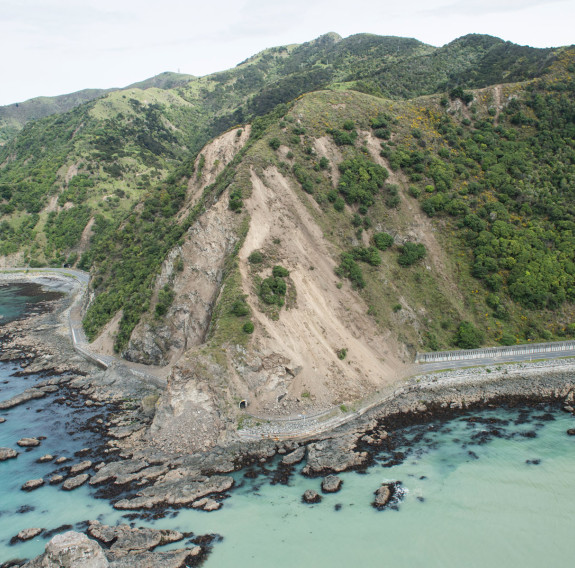
In 2016 a magnitude 7.8 quake struck Kaikōura in the middle of the night. Nationally significant and locally vital road and rail links were buried under enormous landslides, or distorted beyond repair. Landline and mobile phone services went down across the region. Power and water infrastructure was disrupted. From 12:02 am Monday 16 November, Kaikōura was cut off.
14 November 2016
By 12:30am Monday morning the National Crisis Management Centre (NCMC) is operational. Our personnel make their way to the bunker under the Beehive to join Civil Defence & Emergency Management, New Zealand Police, Fire and Emergency New Zealand and a range of other agencies. Once there they set out to understand the scale of the event and coordinate the response. Our personnel liaise with the staff in Headquarters Joint Forces New Zealand, who will be responsible for managing the deployment of our Defence Force's people and equipment. In turn, staff from 'Joint' are getting high readiness teams across the three Services out of bed and up to speed.
As the sun rises, two NH90 helicopters and a P-3K2 Orion aircraft take to the skies to assess the damage. The images that come back to the team in the NCMC show tremendous damage. It becomes quickly apparent that getting immediate help to the now isolated community can only be done by air and sea.
Two NH90 helicopters and a P-3K2 aircraft take to the skies to assess the damage. State Highway 1 is cut off by multiple landslides.
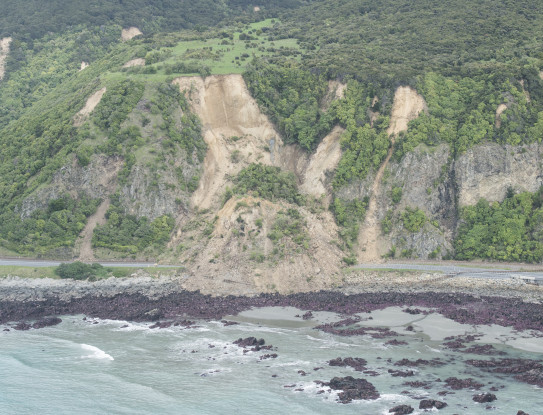
A large landslide blocks State Highway 1 and pushes the railway line into the sea in Kaikoura.
The first NH90 helicopters land in Kaikōura by midday carrying emergency responders from our Defence Force, New Zealand Police, Fire and Emergency New Zealand and other agencies. The helicopters set about creating an air bridge, carrying aid into the town and evacuating those in need of medical support, displaced residents and stranded tourists. The air bridge will operate for another week. HMNZS Canterbury and HMNZS Wellington depart Auckland, loaded with people, equipment and supplies, at 11pm.
15 - 16 November 2016
At sea, hydrographic survey teams from HMNZS Wellington begin mapping the dramatic changes in the seabed around Kaikōura. Because parts of the seabed have lifted up to a metre, new charts are needed so that HMNZS Canterbury and her landing craft can start mass evacuations of the stranded tourists to Lyttelton.
At the time of the quake, New Zealand is hosting a number of international navies in Auckland to celebrate our Royal New Zealand Navy's 75th birthday. Australia, Canada and the United States offer support to New Zealand. A task force of three frigates and a destroyer, (HMNZS Te Kaha, HMAS Darwin from Australia, HMCS Vancouver from Canada and USS Sampson from the US) are diverted to Kaikōura to support the airlift of supplies into the stricken town. Helicopters from these vessels will spend days ferrying aid and supplies into Kaikōura from the deck of HMNZS Canterbury. International air assets - a US P3 Orion and Japanese Kawasaki P1 - also support the response by conducting aerial assessments of the damage.
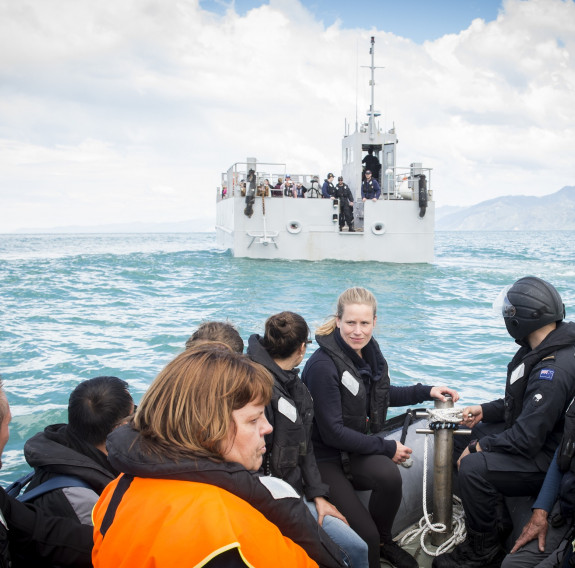
The New Zealand Defence Force helping evacuate travellers and locals from Kaikoura following a magnitude 7.5 Earthquake
3rd Combat Service Support Battalion convoy making their way to Kaikoura to deliver Civil Defence support in 2016 following a magnitude 7.5 Earthquake.
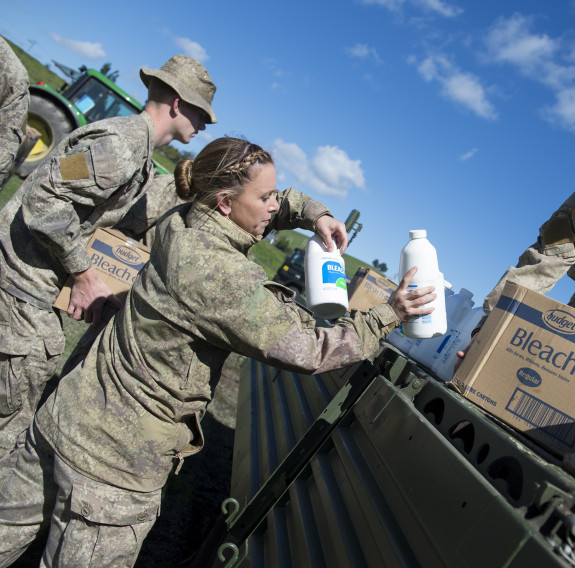
Personnel unload aid supplies from a truck in Kaikoura following a magnitude 7.5 Earthquake.
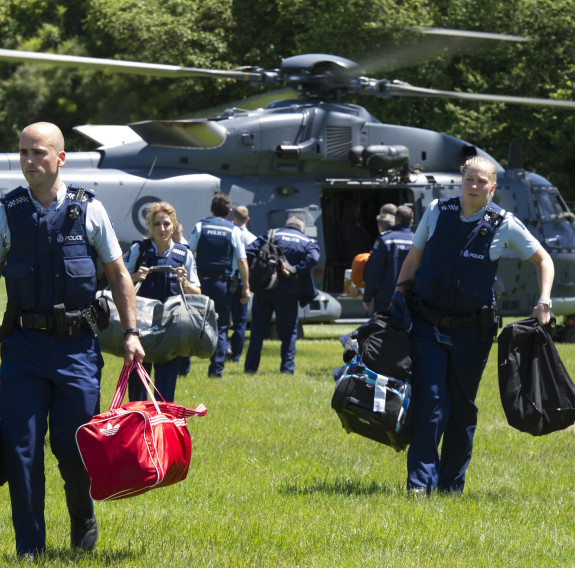
An Air Force NH90 Helicopter arrive in Kaikoura with Police and supplies following an earthquake on 14 Nov 16.
18-20 November 2016
While aid has been coming in by air, by way of helicopter and air drops of water and supplies from C-130H(NZ) Hercules aircraft, Kaikōura needs a land route to get the job of rebuilding underway. The first Army convoy of 27 trucks arrive in town following a gruelling four-hour overland route. The convoy brings fuel, food and construction materials. The route they take will become the main access to Kaikōura and the region for more than a year.
133t
aid delivered overland by
the new zealand army
HMNZS Canterbury, having offloaded 214 tonnes of aid by helicopter, sails for Christchurch carrying 640 evacuees, 9.4 tonnes of luggage, 17 dogs and 30,000 bees. In total NZDF evacuates nearly 1000 people from the quake affected area.
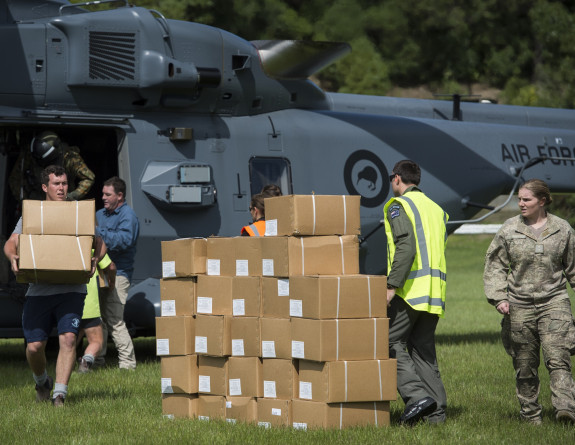
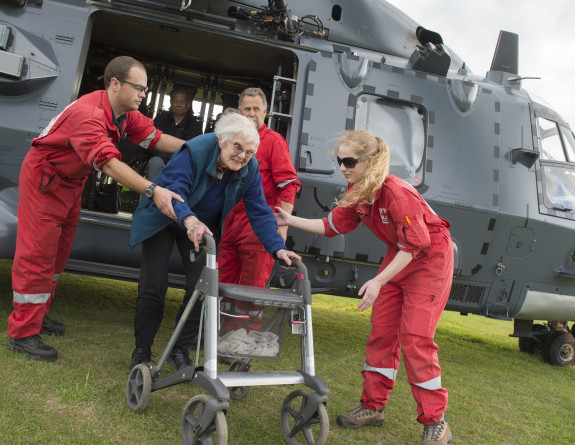
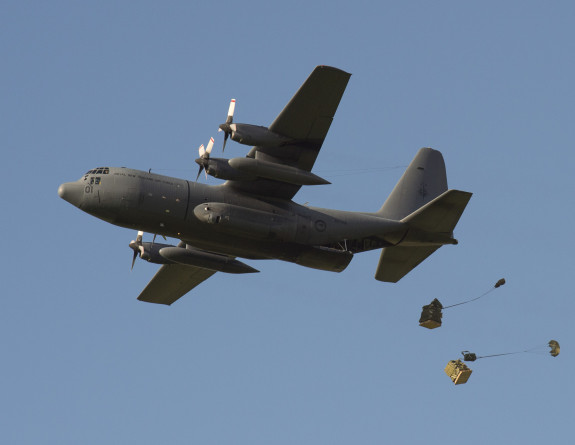
20 November - 13 December 2016
Army personnel strike out across Kaikōura tidying up the damaged town, boarding up broken windows and knocking on doors to check on residents. They fly out to remote settlements in the affected area to make sure those areas are reconnected with New Zealand and are included in the rebuild work that is getting underway.
Convoys of our Army's Medium to Heavy Operational Vehicles (MHOV) help get the town's supermarket back up and running so the community can start recovering some semblance of normality. An Army kitchen is set up to feed the hundreds of people from across our Defence Force, Government and supporting agencies who arrive in town to support the response. Our Air Force water specialists test water around the region to ensure the safety of the supply. A range of our personnel from planners to carpenters work alongside other government agencies in Kaikōura until mid-December.